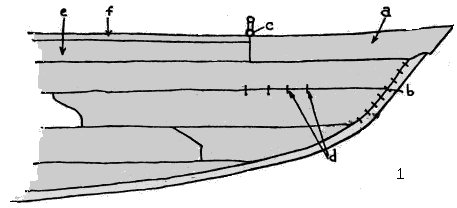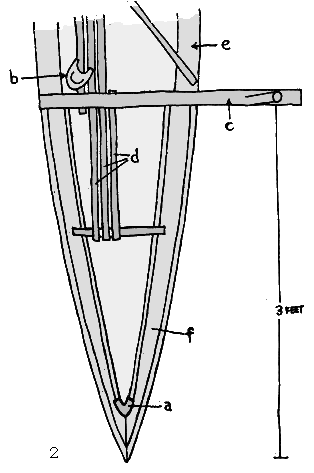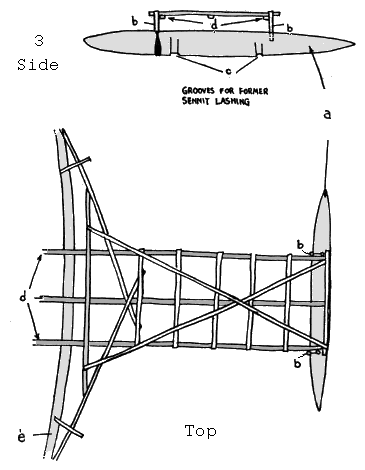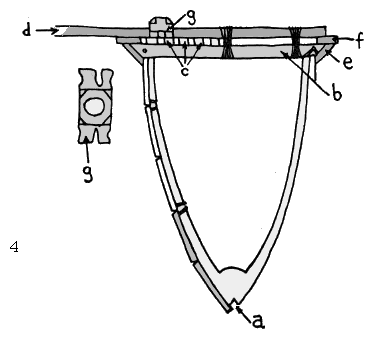The Gilbertese canoe illustrated was sketched in
a village on an islet at the southern end of Tarawa
Atoll. Little concerning its construction or its
ownership could be learned because the natives at this
village spoke no English. The author was on duty in the
area too short a time to pursue the study more
thoroughly.
Canoes built by the Gilbertese are of plank
construction in marked contrast to the dugouts built by
the natives of the Ellice Islands, the neighboring group
of atolls to the south. In an earlier day, Gilbert
Islanders hewed the planks for their canoes from trunks
of trees growing on the islands or from logs cast up on
the beaches. At present, however, according to a native
informant contacted briefly at a later date, planks are
obtained either new from traders, as driftwood lumber, or
from previously constructed canoes.
The canoe described here was twenty-seven feet long,
eighteen inches in beam, and thirty inches from keel to
the upper edge of the gunwale. Throughout its
construction no other fastening medium than sennit cord,
from coconut-husk fiber, appeared to have been used. The
planks along the side (Fig. 1), five in number, were
about three-fourths of an inch thick. Since no one plank
was long enough to extend from stem to stern, numerous
joints were necessarily made to obtain the length
desired. Two of these are shown (Fig. 1). Both were good
examples of the carpenter's art. The final junction was
achieved, as everywhere else in the boat, by tying with
sennit cord.

At their edges the planks were tied together at
intervals of four inches through matching awl-holes (Fig.
1, d). At places of stress, particularly where the bottom
plank met the keel and also where the ends of the planks
met the bow and stern pieces (Fig. 2 a) the intervals
between the ties were reduced to two inches (Fig. 1
b).
The one-piece rib units require little description.
However they were beautifully worked to an even thickness
of about two inches with the same care of construction
shown in all the workmanship in the boat. At the center
of the bottom of each rib unit was a notch clearly shown
in the sketch (Fig 4 a), which permitted water to gather
at one place in the boat thus facilitating bailing.
Lashed securely to each pair of ribs was a thwart (Fig. 4
b) about one and a half inches square in
cross-section.

To these cross pieces were secured the slats which
formed the half deck (Figs. 2 d, 4 c) built on the
outrigger side of the boat. To their opposite ends were
fastened the flaring weather boards (Fig. 4 e) and the
wider deck boards (Figs. 4 f, 3 e, 2 e) on both sides of
the canoe.
The outrigger float (Fig. 3 a) had been employed
formerly on some other craft where the natural forks
(Fig. 3 b) used to elevate the boom had been placed
considerably closer together than in this boat. The great
skill of the canoe maker who had originally used the
float was amply shown by the care with which he had
faired the sennit fastenings into the body of the float
(Fig. 3 c) to present the least possible resistance to
the water. The three parallel outrigger poles and the
crossed strengthening members were of material two inches
wide and an inch and a half thick (Figs. 3 d, 4 d). The
parallel poles extended twelve feet beyond the side of
the boat and were spaced two feet apart. Each pole was
lashed rigidly to a corresponding thwart. The detail of
the outrigger pole assembly may be seen in Fig. 3 and
requires no comment.

No mast was in evidence, although what appeared to be
a stepping block was tied securely to a thwart and to the
strips that formed the half deck. The block was secured
at the outrigger side of the boat amidship.
Two blocks (Fig. 2 b) apparently designed to hold the
butts of fish spears or paddles were tied to the half
decking near both stem and stern of the boat in the same
relative position as the one shown. The other portion of
the rest consisted of a pair of poles with a forking
branch left intact (Figs. 2 c, 1 c) fastened so that the
fork end extended approximately eighteen inches beyond
the side of the boat opposite the outrigger. These were
located, one where the bow piece met the center section
of the canoe, and the other where the stern piece did the
same, as shown in Figure 2.
Only one paddle was seen, and it may or may not
have been a representative example. The blade was about
six inches in width by a foot in length, and tapered to a
rounded point. The two-and-a-half-foot handle of the
paddle had been extended by the addition of a shaft an
inch and a quarter in diameter and somewhat more than
five feet long. The joint uniting the two pieces was a
simple tapered joint securely tied with sennit cord.
The bow and stern were identical. A flaring pair of
boards (Fig. 2 f) at the bow were apparently designed to
make the knife-like boat drier and more comfortable in a
sea. Even for lagoon use, the bow boards would be helpful
because at the down-wind end of this atoll's big lagoon
the strong afternoon breezes are capable of kicking up a
sizeable chop. Naval whaleboats have been swamped within
the lagoon on a brisk day.
However, the same winds that threaten the canoes with
swamping assist them at flying nimbly around the enclosed
waters. The natives are not unaware of the graceful
appearance of their craft and expertly take great
pleasure at displaying them at their best, i.e. heeling
with the wind, with the float raised above the surface to
reduce the drag.
